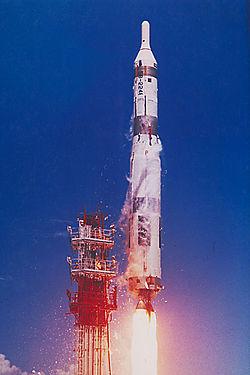
The 526th Intercontinental Ballistic Missile Systems Group is an inactive United States Air Force (USAF) unit. It was last located at Hill AFB, Utah, where it was inactivated in 2010. The group was first activated during World War II to conduct anti-submarine warfare in the Caribbean and off the Atlantic seaboard of Georgia and Florida. It was again active during the Cold War as an Atlas missile wing. Its final period of active service was as a systems and sustainment organization for USAF missile systems.

The 490th Bombardment Group is a former United States Army Air Forces unit. The group was activated in October 1943. After training in the United States, it deployed to the European Theater of Operations and participated in the strategic bombing campaign against Germany from 31 May 1944 to 20 April 1945, losing 22 aircraft while flying more than 5,000 sorties. Following V-E Day, the group returned to the United States, where it was inactivated in November 1945.

The 909th Air Refueling Squadron is part of the 18th Wing at Kadena Air Base, Japan. It operates the KC-135 Stratotanker aircraft conducting air refueling missions.

The 419th Flight Test Squadron is a United States Air Force squadron. It is assigned to the 412th Operations Group, Air Force Materiel Command, stationed at Edwards Air Force Base, California.
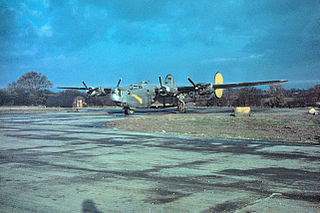
The 847th Bombardment Squadron is a former United States Army Air Forces unit that was originally activated as the 421st Bombardment Squadron. Its last assignment was with the 489th Bombardment Group at Great Bend Army Air Field, Kansas where it was inactivated on 28 March 1945. As the 20th Antisubmarine Squadron, the squadron performed antisubmarine patrols in 1942 and 1943. After reforming as a heavy bomber squadron, it engaged in the strategic bombing campaign against Germany in the European Theater of Operations until returning to the United States in late 1944. The squadron was inactivated while its parent group was training as a very heavy bombardment unit.
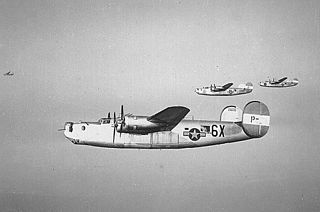
The 855th Bombardment Squadron is an inactive United States Air Force unit. The squadron was first activated as the 522d Bombardment Squadron at Lantana Airport, Florida, in October 1942, when it assumed the personnel and equipment of a National Guard unit engaged in antisubmarine warfare over the Atlantic. The squadron continued antisubmarine patrols as the 17th Antisubmarine Squadron until the summer of 1943, when its mission was transferred to the Navy.

The 831st Bombardment Squadron was a squadron of the United States Army Air Forces. It was activated in 1942 as the 516th Bombardment Squadron and flew antisubmarine missions off the Atlantic coast as the 11th Antisubmarine Squadron. Later, it saw combat in the Mediterranean Theater of Operations as a Consolidated B-24 Liberator unit, where it earned a Distinguished Unit Citation during the strategic bombing campaign against Germany. Following V-E Day, the squadron returned to the United States and was inactivated at Sioux City Army Air Base, Iowa on 20 August 1945.

The 859th Special Operations Squadron is a reserve unit of the United States Air Force. It was first activated in October 1942 as the 517th Bombardment Squadron, when the Army Air Forces replaced National Guard observation units that had been mobilized and were performing antisubmarine patrols off the Atlantic coastline. A month after its activation, the squadron was redesignated the 12th Antisubmarine Squadron. In August 1943, the Army Air forces began turning the antisubmarine patrol mission over to the Navy and the squadron moved to California, where, as the 859th Bombardment Squadron, it formed the cadre for the 492d Bombardment Group.

The 835th Bombardment Squadron is an inactive United States Army Air Forces unit. It was activated in January 1941 as the 80th Bombardment Squadron and equipped with Douglas A-20 Havoc light bombers. Following the attack on Pearl Harbor the squadron began to fly antisubmarine patrols off the Atlantic coast and over the Caribbean Sea, becoming the 9th Antisubmarine Squadron.

The 863rd Bombardment Squadron is a former United States Army Air Forces unit. It was first organized as the 518th Bombardment Squadron in October 1942, when it replaced a National Guard unit participating in antisubmarine patrols off the Atlantic coast, becoming the 13th Antisubmarine Squadron in November. When the Navy took over the coastal antisubmarine mission in August 1943, the squadron moved to the western United States, where it formed the cadre for the 493rd Bombardment Group and was redesignated as the 863rd. It moved to England in the spring of 1944 and participated in the strategic bombing campaign against Germany until April 1945. It returned to the United States and was inactivated in August 1945.
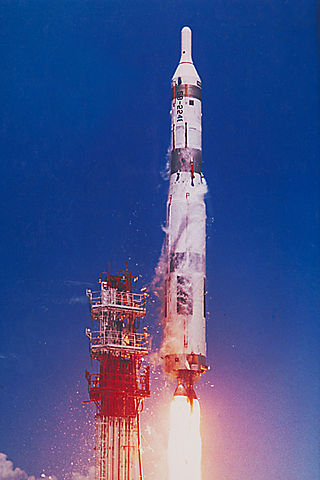
The 850th Strategic Missile Squadron is an inactive United States Air Force unit. It was last assigned to the 44th Strategic Missile Wing at Ellsworth Air Force Base, South Dakota, where it was inactivated on 25 March 1965. The squadron was first activated in 1943 as the 850th Bombardment Squadron. After training in the United States, it deployed to the European Theater of Operations and participated in the strategic bombing campaign against Germany. Following V-E Day, the squadron returned to the United States, where it was inactivated in November 1945.

The 848th Strategic Missile Squadron is an inactive United States Air Force unit. It was last assigned to the 703d Strategic Missile Wing at Lowry Air Force Base, Colorado, where it was inactivated on 1 July 1961. The squadron was first activated in 1943 as the 848th Bombardment Squadron during World War II. After training in the United States, it deployed to the European Theater of Operations and participated in the strategic bombing campaign against Germany. Following V-E Day, the squadron returned to the United States, where it was inactivated in November 1945. It was activated as an intercontinental ballistic missile squadron in 1960.

The 725th Strategic Missile Squadron is an inactive United States Air Force unit. It was last assigned to the 451st Strategic Missile Wing at Lowry Air Force Base, Colorado, where it was inactivated on 25 June 1965.

The 724th Strategic Missile Squadron is an inactive United States Air Force unit. It was last assigned to the 451st Strategic Missile Wing at Lowry Air Force Base, Colorado, where it was inactivated on 25 June 1965.

The 395th Tactical Missile Squadron is a United States Air Force unit. It has not been active under that name.

The 532d Training Squadron is a United States Air Force unit, assigned to the 82nd Training Group at Vandenberg Space Force Base, California. The squadron was first activated in 1942 as the 532d Bombardment Squadron. After training in the United States, it moved to England and engaged in strategic bombing campaign against Germany with Boeing B-17 Flying Fortress bombers. In the European Theater of Operations, it earned two Distinguished Unit Citations. It returned to the United States after the war and was inactivated. The squadron was activated briefly in the reserves from 1947-1949, but was not fully manned or equipped.

The 569th Strategic Missile Squadron is an inactive United States Air Force unit. It was last assigned to the 9th Strategic Aerospace Wing at Mountain Home Air Force Base, Idaho. It was equipped with the first-generation SM-68 Titan I intercontinental ballistic missile, with a mission of nuclear deterrence. The squadron was inactivated as part of the phaseout of the Titan I ICBM on 25 June 1965.

The 372nd Bombardment Squadron is an inactive United States Air Force unit. Its last assignment was with the 307th Bombardment Wing at Lincoln Air Force Base, Nebraska, where it was inactivated on 25 March 1965.
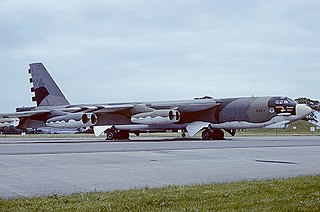
The 644th Bomb Squadron is an inactive United States Air Force unit. It was last assigned to the 410th Bombardment Wing at K. I. Sawyer Air Force Base, Michigan, where it was inactivated on 21 November 1994.

The 839th Bombardment Squadron is an inactive United States Army Air Forces unit. It was activated in January 1941 as the 79th Bombardment Squadron and equipped with Douglas A-20 Havoc light bombers. Following the attack on Pearl Harbor the squadron began to fly antisubmarine patrols off the Atlantic coast and over the Caribbean Sea, becoming the 8th Antisubmarine Squadron.
